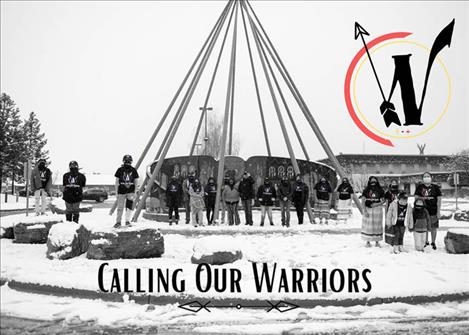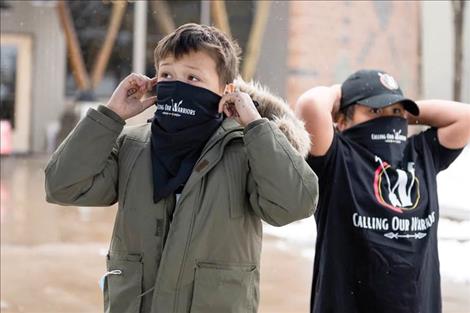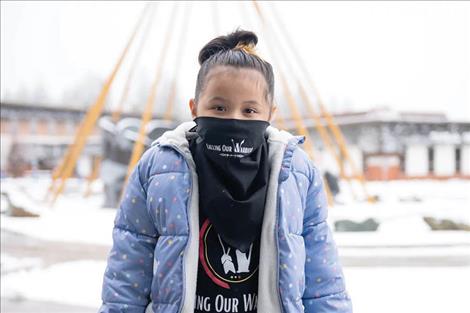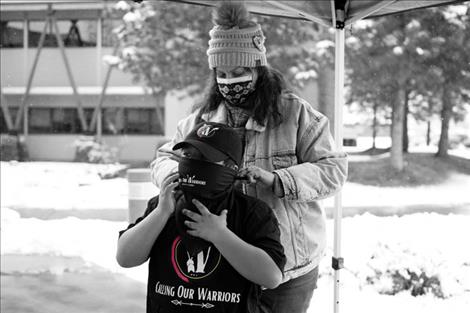‘Calling Our Warriors’ documentary released
Hey savvy news reader! Thanks for choosing local.
You are now reading
1 of 3 free articles.
FLATHEAD RESERVATION — Michelle Mitchell, head of the CSKT Tribal Education Department, says her own battle with COVID-19 inspired her to make the powerful new documentary, “Calling Our Warriors.”
“The idea came at a time when, after doing everything I could to keep myself and my close family safe, we tested positive with breakthrough cases,” says Mitchell. “I ended up with the worst of it.”
She was very ill for six weeks and continues to monitor her oxygen levels daily while periodically “tethered to an oxygen machine.”
As yet another wave of the pandemic washes across the United States, fueled by the new Omicron variant, the virus first identified two years ago in China continues to claim lives and compromise people’s health and future.
On Jan. 3, the Montana Department of Health and Human Services COVID tracker posted 815 new cases, compared to 264 on Dec. 30. In Lake County, where new cases had dropped off significantly since early November, numbers are on the rise again, from just a handful early last week to 22 new cases New Year’s Eve.
So far, COVID has claimed 90 lives in Lake County, and as the documentary points out, more than a third of those (35 people) are tribal members.
The 14-minute film, co-produced by Shadow Devereaux with direction, videography and editing support from Colter Olmstead, features several members of the Salish and Kootenai community discussing their firsthand encounters with the virus.
The documentary aims to combat an increasingly lax attitude about COVID by sharing stories of those whose lives have been altered by it, and encouraging viewers to act as modern-day warriors by getting vaccinated, masking and practicing social distancing.
“Our people have always been warriors,” begins the film. “They shielded and protected us when danger was present. Today we face an invisible threat … we need to be warriors again.”
For the message to have an
impact, its creators sought tribal members who were willing to share their stories.
“Stories are how we relate to each other,” says Mitchell. “We need to make it so it’s no longer a them, it’s an us.”
The resulting interviews offer a riveting portrayal of how COVID has ruined lives, ravaged families, and isolated elders within the close-knit tribal community.
“It’s the hardest thing I’ve had to deal with,” says young Victoria White of losing her beloved “ya-ya” (grandmother) last November. “I didn’t want to be on those machines, and I didn’t want someone I love to be on those machines.”
Former Tribal Chairman Vernon Finley, whose lungs are permanently scarred from COVID-induced pneumonia, says his first symptoms were flulike, and he appeared to be recovering until the virus “came back with a vengeance.”
Lucinda Michel, who helped organize banquets for a living, says her first encounter with COVID was rough, but she recovered. The second round, which hit before vaccines were available, almost killed her.
“I couldn’t walk. My legs were so swollen my son, who was 8 at the time, pushed me to the hospital in a wheelchair,” she recalls. Michel was transferred to Missoula with end-stage renal failure and now, over a year later, is on dialysis four hours a day, three times a week, and can barely walk.
“I used to take care of my mom and now my mom takes care of me,” she says. “I have three kids who take care of me and I’m unable to provide for them like I used to. It’s a big difference from where I was a year ago.”
Bud Collicott, an assistant manager at Western Building Center, is young, healthy and has no underlying health conditions. He was unvaccinated when he caught COVID and wound up in the hospital.
“It really messed me up,” he says. “When you’re in the hospital, you can’t see your family, these guys are coming in in suits, you’re so isolated. It just changes your whole perspective.”
After two years of battling the virus, Dr. Michael “Cubby” Pierre, a tribal member and ER doctor at Community Medical Center in Missoula, expresses his frustration with the misinformation that continues to prevent people from getting vaccinated and taking routine precautions like wearing masks and keeping a safe distance in social settings. “It feels unnecessary that we are where we are.”
He offers this sobering observation about COVID patients: “90% of the people admitted to our hospital now are unvaccinated and anecdotally, for me, every person that I’ve intubated, that goes on a ventilator and is unvaccinated just doesn’t survive – 100% mortality rate.”
People who are vaccinated and get the virus are far less likely to end up in the ER, or on a ventilator. “Their odds of getting intubated are a lot lower and their odds of surviving it are a lot higher,” he says. “That’s the point of the vaccine.”
Finley is also a vaccine advocate. “From a cultural perspective my ancestors weren’t stupid,” he says. “When a tool was presented to them that would help make a job easier, make life easier, they took advantage of it.”
“I see vaccination as an important tool,” he adds. “I don’t believe my ancestors would turn away from it.”
Devereaux, a Missoula-based music producer who also worked on a series of music videos produced by the Tribes to help combat COVID, had two go-arounds with the virus.
The first time, “it was tough – definitely not your everyday sickness.” His fever finally broke after six days. His second encounter came after he was vaccinated “so it was much, much easier.”
Despite his own firsthand experience, conducting interviews for the film “was just eye opening,” he says. “I was impacted in a way that made me take it more seriously. That’s what I hope everybody takes away from it.”
So far, the 14-minute documentary has been viewed in its entirety 1,000 times, 2,500 people have watched at least 10 minutes or more, and over 2,000 have visited the website, www.CallingOurWarriors.com.
“I’m so proud of it,” says Mitchell. “I think it did exactly what we were hoping it would do – get people’s attention and then remind them of who we are, that we take care of each other, we don’t just take care of ourselves.”
















.jpg)
.jpg)



